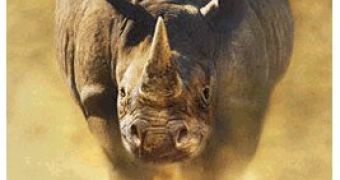"Rhinoceros" comes from Old Greek meaning literally "horned nose". Despite their size and appearance, these huge beasts are related to... horses, asses and zebras. Indeed, the most obvious and distinguishing characteristic of a rhino is its large one or two horns above the nose. Rhinoceros' horns are unique not only because of their position, but also because of their composition and structure, being made only of keratin. Horns of other mammals, like cattle, buffaloes, giraffes, antelopes, sheep, goats, gazelles or pronghorn, have a bony core covered by a sheath of keratin, the same substance found in nails, hair, wool, bird feathers, reptile scales, or in the outer layer of vertebrate skin.
Researchers had believed that the horns are just clumps of agglutinated hair, as at the base they may be crumbling. But CT scans and microscopy revealed their structure resembles that of the hoofs. The horn grows like nails, and in the African black rhino can be 1.4 m (4 ft, 8 in) long while in the case of the African white rhino, which doubles the black rhino in size, it can be even 2 m (6.6 ft) long. If the horn breaks, it grows back by 8 cm (3 in) per year.
Today, these damned horns have been the reason why rhinos die by human hand because many cultures price them for their supposed magical or medicinal qualities. In Malaysia rhino horns are used against malaria, nausea, fever, heart conditions, dementia, toothache. Those medicines have of course the same effect as chewing your nails... Paradoxically, Africans do not regard rhino horns as aphrodisiacs, even if now only Africa delivers rhino horns to the black market.
Rhino horns are the most useless way of wasting money (a lot of it) and time to achieve nothing; its (illegal) usage in traditional Chinese medicine comes from the performances of the animal (rhino sex lasts from 30 minutes to more than one hour) and its large penis (on average 80 cm or 2.5 feet). People regarded the horn as symbol of the sexual power of the rhino, perhaps because the horn could resemble an erect penis. For ignorant minds, that's enough to grind and ingest it to get the rhino's powers. Chewing nails is at least for free and does not kill such a superb beast like a rhino.
In other cultures (like in Yemen or Oman), showing off daggers with handles made of rhino horn is a sign of health... Yemen people say nothing is better for the looks and resistance... The older handlers are more valued, as they get a translucence similar to amber.
Sad ending for these odd and amazing beasts that survived so many geological eras just to end up like this. In the attempt to save the rhinos, many individuals in the African reserves had their horns removed, yet with no results. As the rhino horns cost $4,660 per kilogram (2.2 pounds) (a whole horn bringing $ 25,000), the poachers consider that even what's left after the removal of the horn is worth a lot. In fact, two rhino species (wolly rhino and giant unicorn) from Eurasian steppes might have been wiped out by humans, and all current species are amongst the most endangered big animals.
One myth: is there a black and a white rhino in Africa? No. Both species are gray (with specific hues) but usually what you see is the color of the mud from the last mudbath (pigs are amateurs compared to rhinos in this practice that helps them cool down, chase away flies, eliminate skin parasites and... meet another rhino).
Their name comes from a mistranslation from Afrikaans (the Dutch variant spoken by the South African Boers): they called the animal "wyd" rhino ( meaning "wide") because the animal, a grazer, has wide lips, while the black rhino, feeding on leaves and twigs, has a pointed mouth.
There is a widespread belief that the black rhino is much more aggressive than the white rhino, but in fact the white rhino too can be dangerous if provoked. Because rhinos have poor eyesight, they will attack anything they can hear and smell well, from butterfly sized to train sized objects. And despite the huge stature, rhinos can run with 55 km (34 mi) per hour and make rapid turns of 180'!

 14 DAY TRIAL //
14 DAY TRIAL //